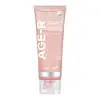What's inside
What's inside
 Key Ingredients
Key Ingredients

No key ingredients
 Benefits
Benefits

 Concerns
Concerns

 Ingredients Side-by-side
Ingredients Side-by-side

Water
Skin ConditioningMethylpropanediol
SolventGlycereth-26
HumectantGlycerin
HumectantNiacinamide
Smoothing1,2-Hexanediol
Skin ConditioningPolyglycerin-3
HumectantMethyl Gluceth-20
HumectantMethyl Gluceth-10
EmulsifyingCaprylic/Capric Triglyceride
MaskingAcrylates/C10-30 Alkyl Acrylate Crosspolymer
Emulsion StabilisingTromethamine
BufferingAllantoin
Skin ConditioningC12-14 Pareth-12
EmulsifyingSoluble Elastin
Skin ConditioningEthylhexylglycerin
Skin ConditioningParfum
MaskingAdenosine
Skin ConditioningSodium Hyaluronate
HumectantEclipta Prostrata Extract
Skin ConditioningButylene Glycol
HumectantMelia Azadirachta Leaf Extract
Skin ConditioningSoluble Collagen
HumectantMoringa Oleifera Seed Oil
EmollientPhosphatidylcholine
EmulsifyingHyaluronic Acid
HumectantSodium Hyaluronate Crosspolymer
HumectantHydrolyzed Sodium Hyaluronate
Skin ConditioningHydrolyzed Hyaluronic Acid
HumectantSodium Dna
Skin ConditioningAtelocollagen
Skin ConditioningDesamido Collagen
Skin ConditioningCeramide NP
Skin ConditioningPrunella Vulgaris Extract
AntioxidantFucus Vesiculosus Extract
EmollientHydrolyzed Collagen
EmollientSodium Acetylated Hyaluronate
HumectantHydroxypropyltrimonium Hyaluronate
Collagen
MoisturisingCollagen Amino Acids
MoisturisingGlycine
BufferingSerine
MaskingProcollagen
Skin ConditioningGlutamic Acid
HumectantLysine
Skin ConditioningAlanine
MaskingThreonine
Proline
Skin ConditioningArginine
MaskingWater, Methylpropanediol, Glycereth-26, Glycerin, Niacinamide, 1,2-Hexanediol, Polyglycerin-3, Methyl Gluceth-20, Methyl Gluceth-10, Caprylic/Capric Triglyceride, Acrylates/C10-30 Alkyl Acrylate Crosspolymer, Tromethamine, Allantoin, C12-14 Pareth-12, Soluble Elastin, Ethylhexylglycerin, Parfum, Adenosine, Sodium Hyaluronate, Eclipta Prostrata Extract, Butylene Glycol, Melia Azadirachta Leaf Extract, Soluble Collagen, Moringa Oleifera Seed Oil, Phosphatidylcholine, Hyaluronic Acid, Sodium Hyaluronate Crosspolymer, Hydrolyzed Sodium Hyaluronate, Hydrolyzed Hyaluronic Acid, Sodium Dna, Atelocollagen, Desamido Collagen, Ceramide NP, Prunella Vulgaris Extract, Fucus Vesiculosus Extract, Hydrolyzed Collagen, Sodium Acetylated Hyaluronate, Hydroxypropyltrimonium Hyaluronate, Collagen, Collagen Amino Acids, Glycine, Serine, Procollagen, Glutamic Acid, Lysine, Alanine, Threonine, Proline, Arginine
Ingredients Explained
These ingredients are found in both products.
Ingredients higher up in an ingredient list are typically present in a larger amount.
Acrylates/C10-30 Alkyl Acrylate Crosspolymer is a synthetic polymer. It is used to thicken and improve the texture of products. Due to its properties, it can prevent water and oil ingredients from separating.
Parfum is a catch-all term for an ingredient or more that is used to give a scent to products.
Also called "fragrance", this ingredient can be a blend of hundreds of chemicals or plant oils. This means every product with "fragrance" or "parfum" in the ingredients list is a different mixture.
For instance, Habanolide is a proprietary trade name for a specific aroma chemical. When used as a fragrance ingredient in cosmetics, most aroma chemicals fall under the broad labeling category of “FRAGRANCE” or “PARFUM” according to EU and US regulations.
The term 'parfum' or 'fragrance' is not regulated in many countries. In many cases, it is up to the brand to define this term.
For instance, many brands choose to label themselves as "fragrance-free" because they are not using synthetic fragrances. However, their products may still contain ingredients such as essential oils that are considered a fragrance by INCI standards.
One example is Calendula flower extract. Calendula is an essential oil that still imparts a scent or 'fragrance'.
Depending on the blend, the ingredients in the mixture can cause allergies and sensitivities on the skin. Some ingredients that are known EU allergens include linalool and citronellol.
Parfum can also be used to mask or cover an unpleasant scent.
The bottom line is: not all fragrances/parfum/ingredients are created equally. If you are worried about fragrances, we recommend taking a closer look at an ingredient. And of course, we always recommend speaking with a professional.
Learn more about ParfumSoluble collagen comes from animals and fish. It has a large molecule size, meaning it doesn't get absorbed into skin.
Instead, it sits on top of skin as a humectant to improve skin hydration. It has incredible water-binding properties and creates a water barrier on skin that prevents evaporation.
This ingredient is incredibly gentle and often used to counter more irritating ingredients.
While our skin does have collagen, this ingredient is not used by the skin for anti-aging. Applying collagen topically has not been linked to helping with collagen loss in skin. All the benefits of soluble collagen are related to hydration.
Fun fact: The name "soluble collagen" refers to its ability to dissolve in water.
Learn more about Soluble CollagenWater. It's the most common cosmetic ingredient of all. You'll usually see it at the top of ingredient lists, meaning that it makes up the largest part of the product.
So why is it so popular? Water most often acts as a solvent - this means that it helps dissolve other ingredients into the formulation.
You'll also recognize water as that liquid we all need to stay alive. If you see this, drink a glass of water. Stay hydrated!
Learn more about Water